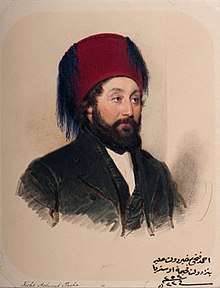Ahmed Fethi Pasha
Rodosizade Ahmed Fethi Pasha (born 1801 in Rhodes – died 1858 in Constantinople), was an Ottoman marshal, ambassador and industrialist, who belonged to the Turks of the Dodecanese.
Ahmed Fethi | |
|---|---|
 Ahmed Fethi Pasha by Moritz Michael Daffinger | |
| Ambassador to Russia | |
| In office 1833–1834 | |
| Ambassador to Austria | |
| In office 1834–1836 | |
| Ambassador to France | |
| In office 1837–1839 | |
| Personal details | |
| Born | Ahmed Fethi c. 1801 Rhodes |
| Died | c. 1858 (aged 56–57) Constantinople, Ottoman Empire (present day Istanbul, Turkey) |
| Spouse(s) | Ayşe Şemsinur Hanım |
| Occupation | Field marshal, ambassador and industrialist |
Career
Prior to becoming a Marshal, Ahmed served as ambassador to Russia in 1833, Austria in 1834-1836 and France in 1837-1839.[1] His last diplomatic assignment was as the representative of the Ottoman Empire at Queen Victoria's coronation.[1] In 1839, Ahmed returned to Constantinople for Sultan Abdulmejid I's coronation and to marry Abdulmecid's sister Atiye Sultan.[2]
As an industrialist he was intent on bringing the Ottoman Empire into the modern age. Ahmed started steel factories and the famous Beykoz porcelain factory, which carried the insignia Product of Istanbul (Eser-i Istanbul).[2]
In 1846, Ahmed, now marshal of the Imperial arsenal,[3] turned the Hagia Irene into a military antiques museum.[4] It is possible Ahmed gained his inspiration for the conversion of the Hagia Irene into a museum, from touring European museums during his career as an ambassador.[5] Through his work, he created the first Ottoman museum.[3]
Descendants
From his first wife Ayşe Şemsinur Hanım (died 4 July 1881), Fethi Pasha had two sons, Mehmed Besim Bey and Damad Mahmud Celaleddin Pasha (died 1884), and two daughters Yeğane Hanım and Emine Güzide Hanım (1848 – 1909).[6] From his second wife, Atiye Sultan, he had two daughters, Seniye Hanımsultan (3 October 1843 – 10 December 1910) and Feride Hanımsultan (30 May 1847 – 1920).[7]
Mahmud Celaleddin Pasha married Cemile Sultan, daughter of Sultan Abdulmejid I and Düzdidil Kadın. The two together had seven children, four sons, Sultanzade Mehmed Celaleddin Bey, Sultanzade Sakıb Bey, Sultanzade Ahmed Fazıl Bey, and Sultanzade Mehmed Kazım Bey, and three daughters, Fethiye Hanımsultan, Fatma Hanımsultan, and Ayşe Sıdıka Hanımsultan.[8][9][10]
Emine Güzide Hanım married Mehmed Said Pasha, and had five children, two sons, Memduh Bey and Mehmed Said Bey, and three daughters, Ayşegül Mediha Hanım, Fatma Saide Hanım, and Saliha Yeğane Hanım.[6]
References
- Wendy M. K. Shaw, Possessors and Possessed: Museums, Archaeology, and the Visualization of History in the Late Ottoman Empire, (University of California Press, 2003), 47. – via Questia (subscription required)
- Wendy M. K. Shaw, Possessors and Possessed: Museums, Archaeology, and the Visualization of History in the Late Ottoman Empire, 48. – via Questia (subscription required)
- Wendy M. K. Shaw, Possessors and Possessed: Museums, Archaeology, and the Visualization of History in the Late Ottoman Empire, 46. – via Questia (subscription required)
- Museums and Narratives of Display from the late Ottoman Empire to the Turkish Republic, Wendy Shaw, Muqarnas, Vol.XXIV, (Brill, 2007), 256.
- Wendy M. K. Shaw, Possessors and Possessed: Museums, Archaeology, and the Visualization of History in the Late Ottoman Empire, 54. – via Questia (subscription required)
- Çağlar, Burhan (September 11, 2011). İngiliz Said Paşa ve Günlüğü (Jurnal). Arı Sanat Yayinevi. p. 93. ISBN 978-9-944-74225-2.
- Adra, Jamil (2005). Genealogy of the Imperial Ottoman Family 2005. pp. 4.
- Çağlar, Burhan (September 11, 2011). İngiliz Said Paşa ve Günlüğü (Jurnal). Arı Sanat Yayinevi. p. 85. ISBN 978-9-944-74225-2.
- Bardakçı, Murat (2008). Son Osmanlılar: Osmanlı hanedanı'nın sürgün ve miras öyküsü. İnkılâp. p. 283. ISBN 978-9-751-02616-3.
- Vâsıb, Ali (2004). Bir Şehzadenin hâtırâtı: vatan ve menfâda gördüklerim ve işittiklerim. YKY. p. 178. ISBN 978-9-750-80878-4.